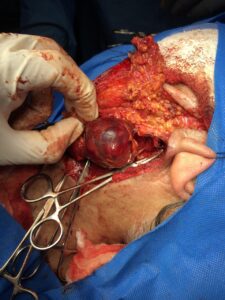Succesfull laparoscopic treatment of cholecystoduodenal fistula (April 2018)
Case report
53 years old female diabetic patient referred by gastroenterologist for laparoscopic cholecystectomy after successful ERCP for CBD stones.She had history of chronic calculous cholecystitis few years ago.
Laparoscopic cholecystectomy done for her and it was difficult case due to adhesions and sever inflammation. The surprise finding was presence of connection and adhesions between GB and duodenum (that did not mention in ERCP report ).
After difficult dissection by fundus first approach and obtaining critical view of safety, the cystic duct and artery clipped and cut.
But the GB still attached to the duodenum via cholecystoduodenal fistula. The fistula transected successfully by linear endoscopic GIA 45 mm stapler.
The postoperative course was uneventful.
Review of the literatures
World J Gastroenterol. 2006 Feb 7;12(5):772-5.
Successful laparoscopic management for cholecystoenteric fistula.
Wang WK1, Yeh CN, Jan YY.
Abstract
AIM: Since 1987, laparoscopic cholecystectomy (LC) has been widely used as the favored treatment for gallbladder lesions. Cholecystoenteric fistula (CF) is an uncommon complication of the gallbladder disease, which has been one of the reasons for the conversion from LC to open cholecystectomy. Here, we have reported four cases of CF managed successfully by laparoscopic approach without conversion to open cholecystectomy.
METHODS: During the 4-year period from 2000 to 2004, the medical records of the four patients with CF treated successfully with laparoscopic management at the Chang Gung Memorial Hospital-Taipei were retrospectively reviewed.
RESULTS: The study comprised two male and two female patients with ages ranging from 36 to 74 years (median: 53.5 years). All the four patients had right upper quadrant pain. Two of the four patients were detected with pneumobilia by abdominal ultrasonography. One patient was diagnosed with cholecystocolic fistula preoperatively correctly by endoscopic retrograde cholangiopancreatography and the other one was diagnosed as cholecystoduodenal fistula by magnetic resonance cholangiopancreatography. Correct preoperative diagnosis of CF was made in two of the four patients with 50% preoperative diagnostic rate. All the four patients underwent LC and closure of the fistula was carried out by using Endo-GIA successfully with uneventful postoperative courses. The hospital stay of the four patients ranged from 7 to 10 d (median, 8 d).
CONCLUSION: CF is a known complication of chronic gallbladder disease that is traditionally considered as a contraindication to LC. Correct preoperative diagnosis of CF demands high index of suspicion and determines the success of laparoscopic management for the subset of patients. The difficult laparoscopic repair is safe and effective in the experienced hands of laparoscopic surgeons.
Published online 2012 Jan 18. doi: 10.1016/S0377-1237(11)60132-9
Successful laparoscopic management of four cases of cholecystoduodenal fistula
Niranjan Dash
Dear Editor,
Cholecystoduodenal fistula (CDF) is an uncommon clinical entity with reported incidences ranging from 0.15% to 5% of biliary disease.1 Chronic cholecystitis with gallstones is the primary aetiology in as many as 75% of CDF patients.2 Cholecystoduodenal type accounts for as many as 80% of cholecystoenteric fistulas (CF).3 Cholecystoduodenal fistula is generally considered to be a relative contraindication to laparoscopic cholecystectomy because of difficulties in its management intra-operatively.4 Laparoscopic stapling technique have been reported as feasible and safe methods to treat such fistula.1,3,5 However, these procedures are not always performed successfully. We are reporting four cases of CDF, managed successfully by laparoscopic approach due to the correct pre-operative diagnosis in one case, and experienced and skilful laparoscopic technique in other three cases.



